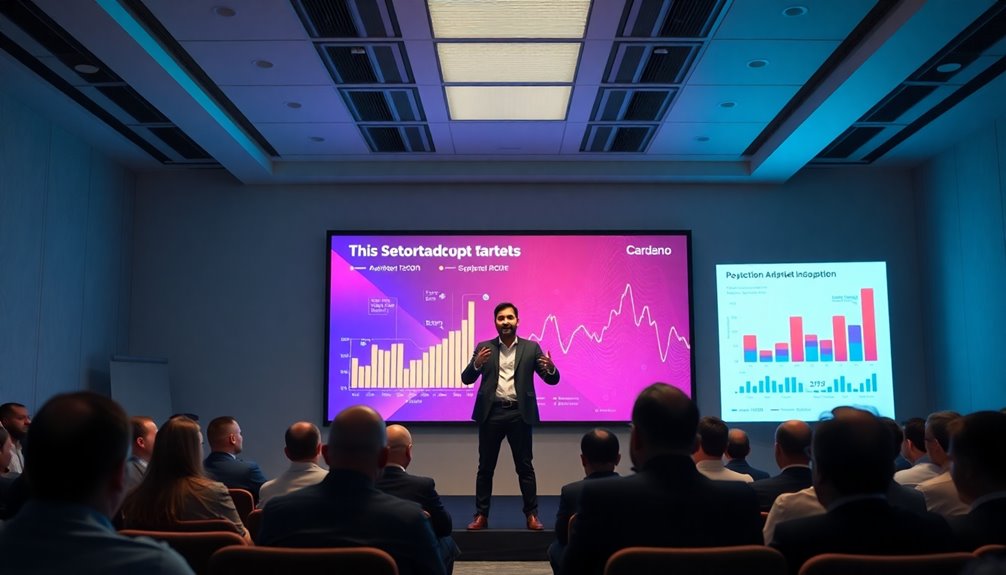Cardano's founder, Charles Hoskinson, recently took to social media to tackle critics, showcasing his platform's governance reforms and regulatory compliance initiatives. He reassured the community about the importance of transparency and accountability, calling for a shift in the governance structure. Amid increasing regulatory scrutiny, Cardano is enhancing its measures to protect user data and ensure compliance with evolving regulations. Hoskinson also highlighted strategic partnerships aimed at boosting Cardano's utility and trust within the market. If you're keen on understanding how these developments impact Cardano's future, there's more insightful information waiting for you.
Founder Addresses Community Concerns

As concerns about Cardano's governance structure grow, founder Charles Hoskinson is stepping up to address the community's worries directly.
He advocates for a community-oriented governance model where members elect leadership, contrasting with the current Swiss-based system criticized for its lack of community input.
Hoskinson suggests relocating to jurisdictions like Abu Dhabi or Wyoming to foster transparency and participation.
He emphasizes the need for accountability mechanisms to ensure decisions align with Cardano's foundational principles. Current board members appointed by the Swiss government contribute to the governance issues that he aims to resolve.
Despite a philosophical divide with the Cardano Foundation, which rejects community-elected leadership, Hoskinson urges you to focus on the bigger picture.
He believes 2025 could be pivotal if the community comes together to build and innovate, setting aside differences for a stronger ecosystem.
Regulatory Scrutiny Intensifies for Cardano

With regulatory scrutiny increasing, Cardano is taking proactive measures to ensure compliance with the evolving landscape of cryptocurrency regulations. The platform is well-prepared for the Markets in Crypto-Assets (MiCA) regulation in Europe, focusing on anti-money laundering, data privacy, and consumer protection. It's implemented tools like Atala Prism for secure identification and community-driven governance through Cardano Improvement Proposals. Additionally, the Cardano Foundation has introduced MiCA-compliant sustainability indicators, showcasing its commitment to transparency and environmental responsibility. Notably, Cardano (ADA) currently trades at $0.923695, reflecting its ongoing efforts to stabilize amid market fluctuations. While challenges in integrating with legacy systems persist, Cardano's adherence to regulations enhances its credibility, attracting institutional interest and boosting market sentiment. Strategic partnerships and regulatory engagement further position Cardano favorably within the dynamic regulatory environment.
Crypto Price Volatility Analysis

The ongoing regulatory scrutiny surrounding Cardano isn't the only factor influencing its market dynamics; price volatility in the crypto space is also shaped by various external pressures.
Market sentiment plays a crucial role; positive news can quickly boost prices, while negative reports often trigger sharp declines. Social media amplifies these reactions, leading to herd behavior fueled by fear or excitement. Additionally, Cardano's high volatility reflects how quickly prices can change, impacting investor sentiment and decisions.
Security breaches can cause panic, resulting in immediate sell-offs and eroding investor confidence. Additionally, the balance between demand and supply significantly impacts price movements. The aftermath of a security breach can lead to heightened volatility in the markets, making accurate assessments more challenging for traders and investors. As a result, many turn to tools such as XRP price prediction analysis to gauge potential future movements and make informed decisions. Understanding market sentiment and dynamics can be crucial in navigating the uncertain landscape that often follows such incidents.
Limited supply can drive prices up, while oversupply may lead to declines. Understanding these factors is essential for navigating the unpredictable nature of the cryptocurrency market.
Corporate Partnerships and Collaborations

Corporate partnerships and collaborations have become vital for Cardano's growth and sustainability in the competitive crypto landscape.
You've seen Cardano team up with companies like New Balance to explore blockchain for supply chain integrity and anti-counterfeiting. The partnership with PwC enhances regulatory compliance, while COTI enables ADA payments for merchants, expanding real-world utility. Moreover, the collaboration with Runtime Verification focuses on enhancing smart contract security through formal verification methods, ensuring robust application development.
Collaborations with SingularityNET focus on integrating AI with blockchain, further enriching the ecosystem. Interoperability efforts with Zilliqa and BitcoinOS are crucial for seamless integration across platforms.
Institutional support from Coinbase Custody adds security and trust. These strategic alliances not only bolster Cardano's presence but also ensure it remains relevant in the evolving digital economy.
Legislative Impact on Cryptocurrency Policies

As lawmakers grapple with the complexities of cryptocurrency, the impact of legislative actions is becoming increasingly significant for the market.
The SEC's skeptical stance may shift depending on upcoming elections and recent court rulings, which could limit its regulatory powers. Ongoing discussions about the balance between innovation and consumer protection in crypto highlight the need for clear guidelines as the regulatory environment evolves.
Meanwhile, various bills like the Strategic Bitcoin Reserve Act and FIT21 propose different regulatory frameworks, indicating a growing interest in structured oversight.
At the state level, initiatives like Arizona's payment bill and Kansas' campaign finance restrictions show diverse approaches.
Congressional efforts continue to evolve, with proposals to place crypto regulation under the CFTC, while ongoing litigation challenges the SEC's authority.
These developments will shape how you engage with cryptocurrencies in the near future.
Market Adoption Trends Analysis

While examining the current landscape of cryptocurrency, it's clear that market adoption trends are shifting significantly, particularly for Cardano (ADA).
Whale investors are accumulating ADA, fueling bullish sentiment among retail investors and often leading to price growth. Technological developments, like the Alonzo upgrade, have attracted developers, enhancing the platform's utility and expanding its user base.
Institutional interest is rising, with partnerships and regulatory clarity contributing to increased investment. Additionally, the Total Value Locked (TVL) in Cardano's DeFi ecosystem has surged, indicating strong organic demand. This surge in TVL has increased by 140 million dollars since the end of December 2024, showcasing the platform's growing appeal among investors.
As positive market sentiment persists, you may find that acquiring ADA presents a favorable opportunity for growth in this evolving landscape.
Frequently Asked Questions
What Is Cardano's Unique Selling Proposition Compared to Other Cryptocurrencies?
Cardano's unique selling proposition lies in its modular design and energy-efficient Proof of Stake (PoS) mechanism.
You'll appreciate its focus on functional programming, which enhances testability and maintainability.
Unlike many cryptocurrencies, Cardano prioritizes security through its Ouroboros protocol, ensuring decentralized validation without centralized control.
Plus, its seamless upgrades through the hard fork combinator maintain historical integrity, providing you with a robust and sustainable blockchain experience that stands out in the crypto landscape.
How Does Cardano's Technology Differ From Ethereum's?
When it comes to blockchain, Cardano and Ethereum are like apples and oranges.
Cardano's dual-layer architecture separates transaction processing from smart contracts, enhancing security and efficiency. It uses the Ouroboros Proof of Stake consensus mechanism, which is energy-efficient and rewards stakers.
In contrast, Ethereum started with a single-layer design and has recently transitioned to PoS, aiming for scalability through sharding.
Each has its strengths, but their approaches are distinctly different.
What Are the Long-Term Goals of Cardano's Development Team?
Cardano's development team aims for long-term goals centered on scalability, interoperability, sustainability, and innovation.
You'll see improvements like the Ouroboros Leios protocol for better performance and Hydra for efficient transactions.
They're also focused on fostering a decentralized governance model that encourages community involvement.
With ongoing research and the introduction of the Marlowe programming language, Cardano's committed to creating a robust ecosystem that supports billions of users and diverse decentralized applications.
How Does Cardano Ensure the Security of Its Blockchain?
Cardano's security isn't just robust; it's like a fortress!
It employs a proof-of-stake protocol that's energy-efficient and scales like a champion, ensuring your ADA is safe.
With the extended UTxO model, every transaction you make is shielded from prying eyes, requiring your explicit consent.
Smart contracts are tightly secured, preventing hacks like a digital superhero.
Plus, you're always in control, so you can confidently navigate the blockchain world!
What Communities Are Most Engaged With Cardano's Ecosystem?
You'll find that the most engaged communities within Cardano's ecosystem include Project Catalyst, where developers and investors collaborate on innovative proposals.
The Cardano Forum fosters discussions across various topics, while the Cardano Whale acts as a networking hub for enthusiasts.
Additionally, IOHK community events provide educational opportunities, connecting you with experts.
Together, these communities empower you to contribute meaningfully and stay informed about the latest developments in Cardano.
Conclusion
In navigating the challenges ahead, Cardano's founder emphasizes transparency and community engagement to bolster confidence. As regulatory scrutiny heightens, the project's adaptability will be crucial. For instance, consider how Ethereum overcame early regulatory hurdles by fostering partnerships with established firms, paving the way for broader acceptance. By prioritizing collaboration and innovation, Cardano can not only address current concerns but also position itself for sustainable growth in an evolving crypto landscape.









